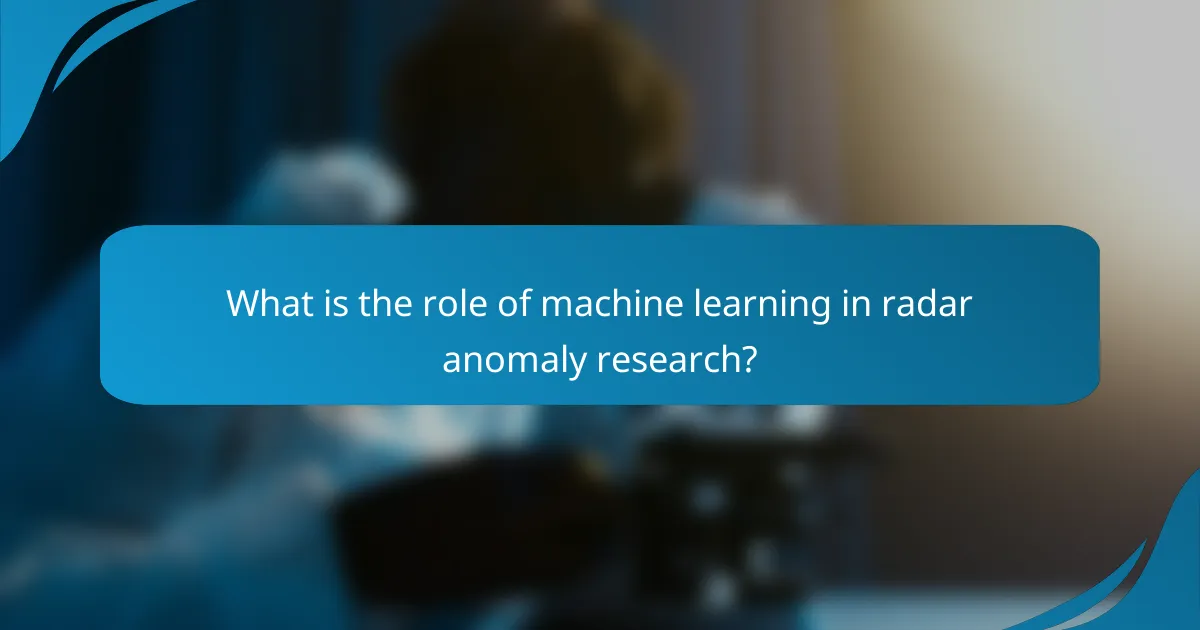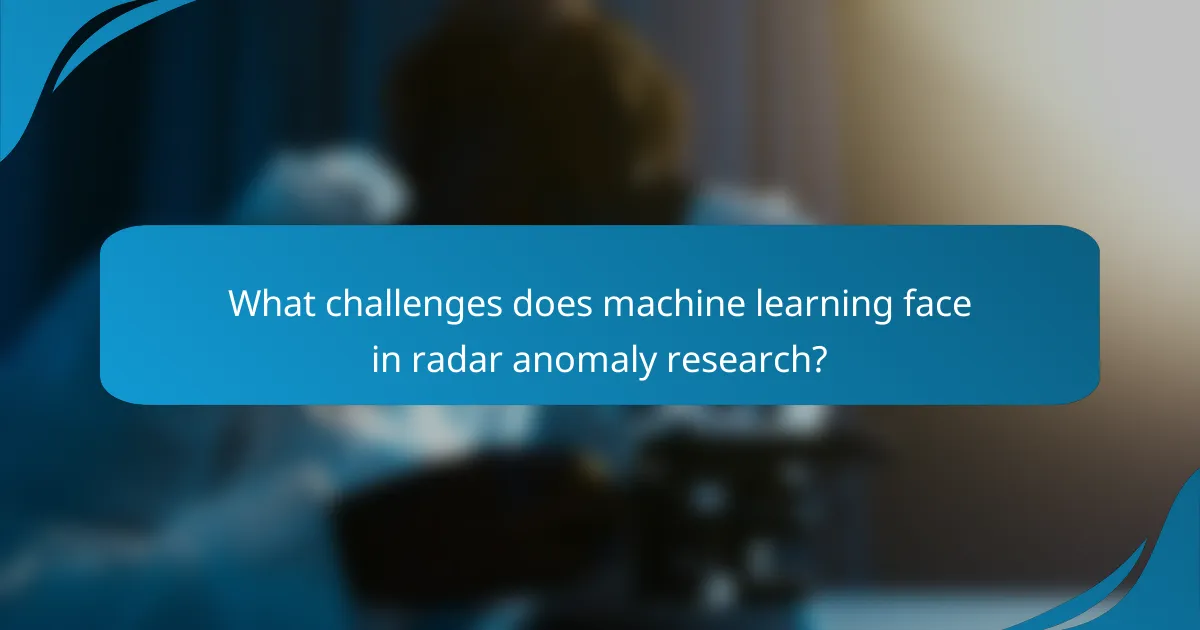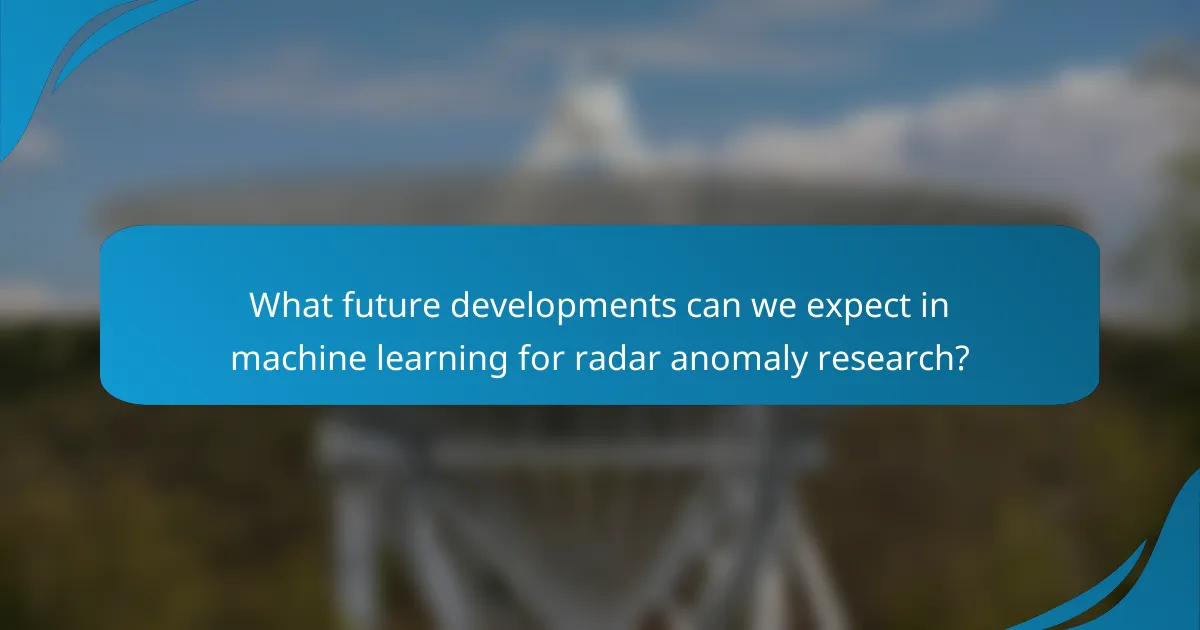Machine learning is a pivotal technology in radar anomaly research, significantly enhancing the detection and classification of unusual patterns within radar data. It automates the analysis of extensive datasets, crucial for identifying potential security threats or system malfunctions. Key machine learning algorithms, including neural networks and support vector machines, improve predictive accuracy and reduce false positive rates in anomaly detection. However, challenges such as data quality, scarcity of labeled examples, and the complexity of radar signals remain. Future advancements are expected to focus on enhanced algorithms, real-time processing, and improved interpretability, driving innovation in radar systems.

What is the role of machine learning in radar anomaly research?
Machine learning plays a crucial role in radar anomaly research by enhancing the detection and classification of unusual patterns in radar data. It enables automated analysis of large datasets, which is essential for identifying anomalies that may indicate security threats or system malfunctions. Machine learning algorithms, such as neural networks and support vector machines, can learn from historical data to improve their predictive accuracy. Studies have shown that these algorithms significantly reduce false positive rates in anomaly detection. For instance, a study published in the IEEE Transactions on Aerospace and Electronic Systems demonstrated that machine learning techniques improved anomaly detection performance by over 30% compared to traditional methods. This advancement allows for timely responses to potential threats, making radar systems more reliable and effective.
How does machine learning enhance radar anomaly detection?
Machine learning enhances radar anomaly detection by improving the accuracy and efficiency of identifying unusual patterns. Traditional methods often struggle with the complexity and variability of radar signals. Machine learning algorithms can analyze large datasets and learn from them to recognize normal behavior. This capability allows them to detect anomalies more effectively. For instance, supervised learning techniques can be trained on labeled data to classify radar returns accurately. Additionally, unsupervised learning can identify patterns without prior labeling, making it adaptable to new environments. Studies show that machine learning models can reduce false alarm rates significantly, leading to more reliable detection systems.
What types of machine learning algorithms are commonly used?
Commonly used types of machine learning algorithms include supervised, unsupervised, and reinforcement learning algorithms. Supervised learning algorithms, such as linear regression and support vector machines, require labeled data for training. Unsupervised learning algorithms, like k-means clustering and principal component analysis, work with unlabeled data to identify patterns. Reinforcement learning algorithms, such as Q-learning, focus on decision-making through trial and error. These algorithms are foundational in various applications, including radar anomaly detection, where they analyze patterns in data to identify abnormal behavior.
How do these algorithms differ in their approach to anomaly detection?
Algorithms differ in their approach to anomaly detection primarily in their methodologies and techniques. Some algorithms, like supervised learning, rely on labeled datasets to identify anomalies by learning from examples. They require extensive training data to classify normal versus anomalous behavior. In contrast, unsupervised learning algorithms detect anomalies without prior labeling. They analyze data patterns and identify outliers based on statistical properties. For example, clustering methods group similar data points and flag those that do not fit well within any cluster as anomalies.
Another difference lies in the use of thresholds. Threshold-based algorithms define a specific limit for data points. Any point exceeding this threshold is considered an anomaly. Alternatively, model-based algorithms create a statistical model of normal behavior and identify deviations from this model as anomalies.
Additionally, some algorithms leverage ensemble methods, combining multiple models to improve detection accuracy. This approach enhances robustness against false positives. Overall, the choice of algorithm affects detection performance, complexity, and adaptability to various data types and environments.
What are the key benefits of using machine learning in radar anomaly research?
Machine learning enhances radar anomaly research by improving detection accuracy and reducing false positives. It analyzes vast datasets quickly, identifying patterns that traditional methods may overlook. Machine learning algorithms adapt to new data, allowing for continuous improvement in anomaly detection. They can process real-time data, enabling timely responses to potential threats. Additionally, machine learning reduces the need for manual intervention, streamlining the research process. Studies show that machine learning can increase detection rates by up to 30%. This technology also enables the identification of previously unknown anomalies, expanding the scope of radar research. Overall, machine learning significantly advances the effectiveness of radar anomaly detection.
How does machine learning improve accuracy in anomaly detection?
Machine learning improves accuracy in anomaly detection by leveraging algorithms that learn from data patterns. These algorithms can identify subtle deviations from normal behavior that traditional methods might miss. Machine learning models can process large datasets quickly, enhancing detection speed and efficiency. They adapt over time, refining their accuracy as they encounter new data. Techniques like supervised learning utilize labeled data to train models, increasing precision in identifying anomalies. Unsupervised learning can discover unknown patterns without prior labels, revealing hidden anomalies. Research shows that machine learning can reduce false positives by up to 50% compared to traditional methods. This capability is crucial in fields like cybersecurity and fraud detection, where accuracy is paramount.
What time-saving advantages does machine learning provide?
Machine learning provides significant time-saving advantages by automating data analysis processes. It can quickly process large datasets that would take humans hours or days to analyze. Algorithms can identify patterns and anomalies in real-time, reducing the time needed for manual inspections. Machine learning models can also learn from previous data to improve their accuracy over time, further decreasing the need for repetitive human intervention. For instance, in radar anomaly detection, machine learning can reduce the time to identify potential threats from hours to mere minutes. This efficiency allows researchers to focus on strategic decision-making rather than data processing tasks.

What challenges does machine learning face in radar anomaly research?
Machine learning faces several challenges in radar anomaly research. Data quality is a significant issue. Inaccurate or noisy data can lead to poor model performance. Another challenge is the scarcity of labeled data for training algorithms. Anomalies are rare, making it difficult to obtain sufficient examples. Additionally, the complexity of radar signals poses a problem. These signals often contain high-dimensional data that can be hard to analyze effectively. Overfitting is also a concern. Models may perform well on training data but fail to generalize to new instances. Finally, interpretability of machine learning models is a challenge. Understanding how decisions are made is crucial in critical applications like radar systems.
What are the limitations of current machine learning algorithms?
Current machine learning algorithms have several limitations. They often require large amounts of labeled data for effective training. This dependency can lead to challenges in data scarcity. Many algorithms also struggle with generalizing to unseen data. Overfitting can occur when models are too complex for the available data. Interpretability remains a significant issue, making it difficult to understand decision-making processes. Additionally, current algorithms can be sensitive to input variations. This sensitivity may result in inconsistent performance in real-world applications. Lastly, computational resource demands can limit accessibility for smaller organizations.
How do data quality and quantity impact machine learning performance?
Data quality and quantity significantly impact machine learning performance. High-quality data ensures accurate model training, while sufficient data quantity provides diverse examples for generalization. Poor data quality can lead to biased models, resulting in incorrect predictions. For instance, a study by Domingos (2012) highlights that models trained on noisy data perform poorly compared to those with clean data. Additionally, insufficient data can lead to overfitting, where models learn noise instead of patterns. Research shows that increasing data quantity can improve model accuracy, as seen in the ImageNet project, which used millions of images to enhance deep learning performance. Thus, both quality and quantity are essential for effective machine learning outcomes.
What are the challenges of integrating machine learning with existing radar systems?
Integrating machine learning with existing radar systems presents several challenges. One challenge is data compatibility. Existing radar systems often produce data in formats not optimized for machine learning algorithms. Another challenge is the need for large datasets. Machine learning requires extensive training data, which may not be readily available from existing radar systems.
Additionally, there are issues with real-time processing. Machine learning algorithms can be computationally intensive, potentially slowing down radar system performance. Model interpretability is also a challenge. Understanding how machine learning models make decisions can be difficult, complicating trust in their outputs.
Furthermore, integrating machine learning necessitates changes in system architecture. Existing radar systems may require significant modifications to accommodate new algorithms. Finally, there are concerns about security and reliability. Machine learning systems can be vulnerable to adversarial attacks, which can compromise radar system integrity.
How can researchers overcome the challenges of machine learning in radar anomaly research?
Researchers can overcome challenges in machine learning for radar anomaly research by employing robust data preprocessing techniques. These techniques enhance data quality and reduce noise, which is critical in radar signal processing. Additionally, utilizing advanced algorithms such as deep learning can improve anomaly detection accuracy. Studies show that deep learning models outperform traditional methods in identifying complex patterns in radar data.
Moreover, researchers can enhance model generalization by incorporating diverse datasets that capture various operational conditions. This approach mitigates overfitting and improves the model’s performance across different scenarios. Collaboration with domain experts can also aid in feature selection and model interpretation, ensuring that the machine learning models are relevant and effective in real-world applications.
Finally, continuous model evaluation and adaptation to new data are essential. Implementing feedback loops allows researchers to refine their models based on emerging trends and anomalies in radar data.
What strategies can improve data collection for machine learning models?
Improving data collection for machine learning models can be achieved through several strategies. First, implementing automated data gathering tools can enhance efficiency. These tools can collect data from various sources in real time. Second, ensuring data diversity is crucial. A diverse dataset helps models generalize better across different scenarios. Third, conducting regular data audits can identify gaps and inconsistencies. This process ensures the data remains relevant and accurate. Fourth, leveraging crowdsourcing can expand data collection efforts. Crowdsourcing allows for a larger volume of data from various contributors. Lastly, utilizing data augmentation techniques can artificially expand datasets. This approach helps improve model robustness without needing additional real-world data. These strategies collectively enhance the quality and quantity of data for machine learning applications.
How can collaboration between fields enhance machine learning applications?
Collaboration between fields can significantly enhance machine learning applications by integrating diverse expertise. This interdisciplinary approach allows for the development of more robust algorithms. For instance, combining insights from radar technology and computer science leads to improved anomaly detection. Researchers from different fields can share unique datasets, enriching the training process. Access to varied data sources enhances model accuracy and generalization. Collaboration also fosters innovative problem-solving techniques tailored to specific challenges. Moreover, cross-disciplinary teams can address ethical considerations more effectively. Thus, diverse collaboration leads to more effective and responsible machine learning solutions in radar anomaly research.

What future developments can we expect in machine learning for radar anomaly research?
Future developments in machine learning for radar anomaly research will likely include enhanced algorithms for anomaly detection. These algorithms will improve accuracy in identifying unusual patterns in radar data. Integration of deep learning techniques will enable more sophisticated analysis of complex datasets. Real-time processing capabilities will be prioritized to facilitate immediate anomaly detection. Advances in transfer learning will allow models to adapt to new environments with minimal retraining. Increased collaboration between researchers and industry will drive practical applications and innovations. Improved data collection methods will provide higher quality inputs for machine learning models. Enhanced interpretability of machine learning models will aid in understanding the decision-making process behind anomaly detections.
How might advancements in technology influence machine learning applications?
Advancements in technology significantly enhance machine learning applications. Improved computational power allows for processing larger datasets efficiently. Enhanced algorithms lead to more accurate predictions and classifications. Access to big data enables training models on diverse and extensive information. Innovations in cloud computing facilitate scalable machine learning solutions. Advanced hardware, such as GPUs, speeds up training times for complex models. Emerging technologies like quantum computing promise exponential increases in processing capabilities. These factors collectively drive the evolution of machine learning, making it more effective in various applications, including radar anomaly detection.
What emerging algorithms show promise for radar anomaly detection?
Emerging algorithms that show promise for radar anomaly detection include deep learning models, particularly convolutional neural networks (CNNs) and recurrent neural networks (RNNs). These models excel at identifying complex patterns in large datasets. CNNs are effective for spatial data analysis, while RNNs handle temporal sequences well. Additionally, unsupervised learning techniques, such as autoencoders, are gaining traction. They can detect anomalies without labeled data, making them versatile for various applications. Research indicates that these algorithms can significantly improve detection rates compared to traditional methods. For instance, a study published in IEEE Transactions on Aerospace and Electronic Systems demonstrated a CNN’s ability to reduce false alarm rates by over 30%.
What are best practices for implementing machine learning in radar anomaly research?
Best practices for implementing machine learning in radar anomaly research include data preprocessing, model selection, and validation techniques. Data preprocessing involves cleaning and normalizing radar data to enhance model performance. Feature extraction is crucial for identifying relevant patterns in the data. Model selection should focus on algorithms suited for time-series data, such as recurrent neural networks or decision trees. Cross-validation techniques ensure that models generalize well to unseen data. Hyperparameter tuning optimizes model performance, enhancing accuracy and reducing overfitting. Continuous monitoring of model performance is necessary to adapt to evolving radar environments. Collaboration with domain experts can provide insights into anomaly characteristics, improving model relevance. These practices are supported by studies indicating that well-implemented machine learning models significantly enhance anomaly detection accuracy in radar systems.
How can researchers ensure the reliability of their machine learning models?
Researchers can ensure the reliability of their machine learning models by implementing rigorous validation techniques. They should use cross-validation methods to assess model performance on different subsets of data. This helps identify overfitting and ensures the model generalizes well. Additionally, researchers should employ a diverse dataset that reflects real-world scenarios. This diversity improves the model’s robustness against various anomalies. Regular performance evaluation using metrics like accuracy, precision, and recall is essential. These metrics provide quantifiable insights into the model’s effectiveness. Researchers can also conduct sensitivity analysis to understand how changes in input affect outputs. This analysis helps identify potential weaknesses in the model. Finally, continuous monitoring and updating of the model with new data can maintain its reliability over time.
What common pitfalls should researchers avoid when using machine learning?
Researchers should avoid common pitfalls when using machine learning. One major pitfall is overfitting, where a model learns noise instead of the underlying pattern. This leads to poor performance on unseen data. Another pitfall is not properly preprocessing data. Inadequate data cleaning can introduce biases and inaccuracies. Ignoring feature selection is also problematic. Irrelevant features can dilute model effectiveness. Additionally, researchers often neglect to validate their models. Without validation, the reliability of results remains uncertain. Lastly, failing to consider ethical implications can lead to biased outcomes. Ethical oversight is crucial in machine learning applications. These pitfalls can significantly impact the success of machine learning projects in radar anomaly research.
The primary entity of this article is machine learning in the context of radar anomaly research. The article explores how machine learning algorithms enhance the detection and classification of anomalies in radar data, significantly improving accuracy and reducing false positive rates. Key topics include the types of algorithms commonly used, their methodologies, the benefits of machine learning in anomaly detection, and the challenges faced in integrating these technologies with existing radar systems. Additionally, it addresses best practices for implementing machine learning and emerging trends that could shape future developments in this field.